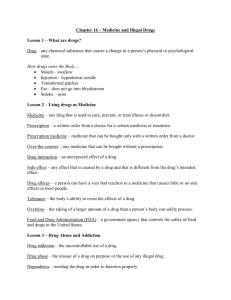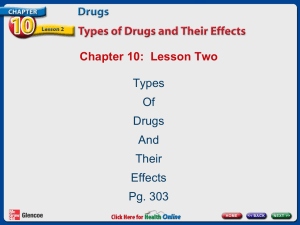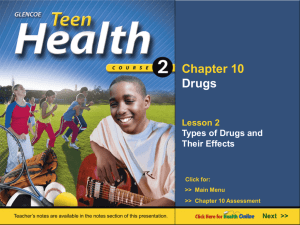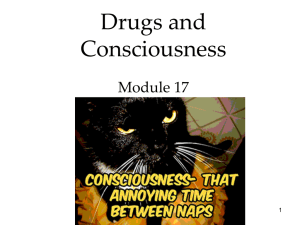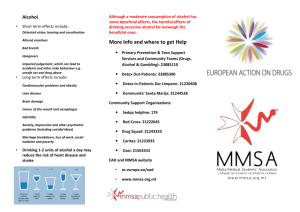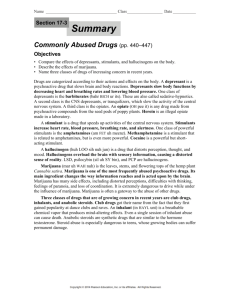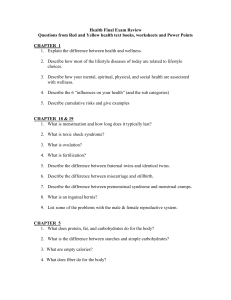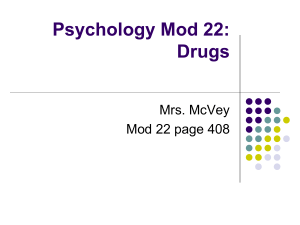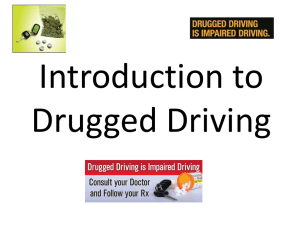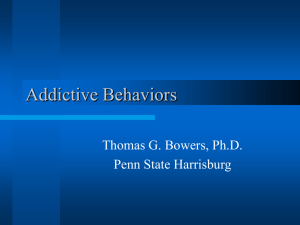drugs - PlazaDeals.net
advertisement
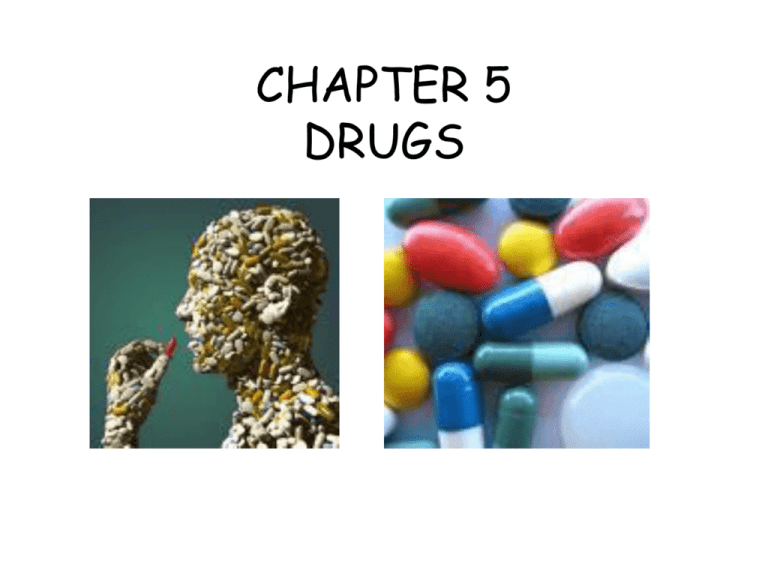
CHAPTER 5 DRUGS NARCOTICS • Narcotics are drugs that induce sleep and relieve pain. • The term narcotic is used incorrectly today…for example the cocaine is labeled as a narcotic but is actually a stimulant • Marijuana has been classified as narcotic but is actually a hallucinogen • OPIATES like Heroin, Morphine, OxyContin, Methadone and Codeine are narcotic. OxyContin What is the difference between Vicoden, OxyContin, Percocet and Percodan • Hydrocodone= Vicoden • Oxycodone = OxyContin (has one extra hydroxyl group –OH) Doses start at 10mg80mg • Percocet= 5mg Oxycodone + Acetamimophen 325mg • Percodan= 5mg Oxycodone+ Aspirin Depressants • OxyContin • Oxycodone vs vs Vicoden Hydrocodone Depressants • Depressants depress (slows down) the central nervous system and reduce pain relieving stress, anxiety, and fear putting the person at ease. • • • • • ALCOHOL is the number one used depressant. Alprazolam (Xanax) Diazepam (Valium) Barbiturates (phenobarbital) **Heroin Inhalants • Inhalants such as glue, paint thinner, and hair spray are also considered depressants and have the same effect as alcohol. Stimulants • Stimulates elevate the mood, producing feelings of excitement, feeling good, and euphoria. • It increases the CNS, pulse and blood pressure • Stimulants give the user an adrenaline rush often followed by a crash. • Heavy use of stimulants result in paranoia, restlessness, fidgetiness, (constant body movements), apathy, irritability, and depression. • The most frequently used stimulant is coffee with caffeine. • The most common illegal stimulant is cocaine and amphetamines. How much caffeine is in your drink? • • • • • • Coke 35mg Mountain Dew 55mg Coffee 50-100mg Red Bull 80mg Monster 160mg (2) REDLINE 325mg (2) No Name: energy drink • May 5, 2007 pulled from self because name was said to be immoral and promoted illegal substance abuse. • Had 240 mg caffeine and 750 mg of taurine (found in seafood and meat…58mg is the average daily intake) • Taurine give energy and has many health benefits Amphetamines • A group of synthetic stimulants that are usually called UPPERS or SPEED. • Used in diet pills • Hydroxycut with Ephedra COCAINE • Erythroxoylon coca – the plant • Causes a euphoric sensation • Suppression of hunger, fatigue, and boredom Nicotine • Is also a stimulant • Found in cigarettes Hallucinogens • Hallucinogens alter perceptual functions or better known as mind-altering drugs. • There are no legalized hallucinogens as this type of drug is extremely dangerous and unpredictable. • The most frequently used hallucinogens are LSD and PCP and mushrooms. • Marijuana is a hallucinogen Hallucinogens • Users may experience what is known as a “good” trip or a “bad” trip. • A “Bad” trip, which is similar to a panic or anxiety attack, can result in violent behavior toward oneself or someone else or the person can suffer a mental breakdown. Marijuana • Marijuana wouldn’t cause the gross hallucinations of hallucinogens or the adrenaline rush of stimulant, nor the complete reduction in pain or immense relaxation of depressants. Club Drugs • Synthetic drugs that are often used at nightclubs, bars and raves (all night dance parties) • MDMA- Ecstasy • *GHB- Gamma Hydrobutyrate – (Depressant) • *Rohyphnol- Roofies (like Xanax/Valium) • Ketamine (Special K)- horse tranquilzer • Methamphetamine * Central nervous system depressants associated with sexual assault/ rape/ robbery. They are odorless, colorless, tasteless thus remain undetected when sipped in a drink STEROIDS- a class of drugs Anabolic Steroids • Anabolic- muscle building • Performance enhancing drugs • Usually given by shots • Could be used by DR for growth hormone treatment or cancer pts Corticosteriods • Used to treat an allergic reaction or inflammatory issue • LEGAL • Can be a shot or pills • Not used by athletes Anabolic Steroids • Synthetic compounds chemically related to the male sex hormone testosterone that are used to promote muscle growth • Could be used by a doctor by Rx for growth or Corticosteroids Drugs closely related to cortisol, a hormone which is naturally produced in the adrenal cortex Corticosteroids act on the immune system by blocking the production of substances that trigger allergic and inflammatory actions, (such as prostaglandins). • • • • • • Corticosteroids include: Betamethasone (Celestone) Budesonide (Entocort EC) Cortisone (Cortone) Dexamethasone (Decadron) Triamcinolone (Kenacort, Kenalog) Hydrocortisone (Cortef) Methylprednisolone (Medrol) Prednisolone (Prelone) Prednisone (Deltasone) Steroids vs NSAID • Both used to reduce inflammation • NSAID= Non-steroidal anti-inflammatory drugs • Non-narcotic • Over-the-counter • Tylenol= Acetaminophen • Advil= Ibuprofen • Bayer= Aspirin (Acetylsalicylic acid) • Aleve= Naproxen DO NOT MIX: • Aleve with Aspirin- anticoagulants • Tylenol with alcohol (Toxic to liver) • Overdosing on Tylenol leads to toxicity of the liver. • When pregnant, Tylenol can be taken for pain or fever reducer. • Aspirin is not used for the flu • All NSAID can cause stomach reflux or ulcers • Aleve can make your skin sensitive to sunlight DEA Drug Schedule The DEA categorizes drugs into 5 schedules Schedule I • Schedule I drugs have a high tendency for abuse and have no accepted medical use. • This schedule includes drugs such as Marijuana, Heroin, Ecstasy, LSD, and GHB. • Recent activists have tried to change the schedule for Marijuana citing the possible medical benefits of the drug. • Pharmacies do not sell Schedule I drugs, and they are not available with a prescription by physician. Schedule II • Schedule II drugs have a high tendency for abuse, may have an accepted medical use, and can produce dependency or addiction with chronic use. • This schedule includes examples such as Cocaine, Opium, Morphine, Fentanyl, Amphetamines, and Methamphetamines. • Schedule II drugs may be available with a prescription by a physician, but not all pharmacies may carry them. • These drugs require more stringent records and storage procedures than drugs in Schedules III and IV. Schedule III • Schedule III Drugs Schedule III drugs have less potential for abuse or addiction than drugs in the first two schedules and have a currently accepted medical use. • Examples of Schedule III drugs include Anabolic steroids, Codeine, Ketamine, Hydrocodone with Aspirin, and Hydrocodone with Acetaminophen. • Schedule III drugs may be available with a prescription, but not all pharmacies may carry them. Schedule IV • Schedule IV drugs have a low potential for abuse, have a currently accepted medical use, has a low chance for addiction or limited addictive properties. • Examples of Schedule IV drugs include Valium, Xanax, Phenobarbital, and Rohypnol (commonly known as the "date rape" drug). • These drugs may be available with a prescription, but not all pharmacies may carry them. Schedule V • Schedule V drugs have a lower chance of abuse than Schedule IV drugs, have a currently accepted medical use in the US, and lesser chance or side effects of dependence compared to Schedule IV drugs. • This schedule includes such drugs as cough suppressants with Codeine. • Schedule V drugs are regulated but generally do not require a prescription.
